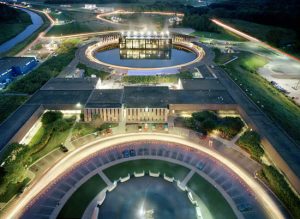 BATAVIA, Ill. – Chicago Mayor Richard Daley announced today (Oct. 2, 2007) that Fermilab in Batavia produced the seventh most important scientific achievement in the six-county Chicago region.
BATAVIA, Ill. – Chicago Mayor Richard Daley announced today (Oct. 2, 2007) that Fermilab in Batavia produced the seventh most important scientific achievement in the six-county Chicago region.
Daley named the top ten scientific innovations, discoveries and events in Chicago history during a ceremony in Daley Plaza. A plaque and banners in plaza commemorate the scientific accomplishments.
The Department of Energy’s Fermi National Accelerator Laboratory earned seventh place for the discovery March 2, 1995, of the top quark, the last of the missing subatomic building blocks thought to make up all the matter in the world, including people, plants and buildings. The top quark plays a role in determining the weight of you and everything around you.
“It is wonderful that a fundamental science discovery about how the universe is made makes it into the top 10 scientific achievements of Chicago,” said Fermilab Director Pier Oddone.
The top quark was one of the key missing pieces in the theory of how matter is formed from a variety of combinations of 12 elementary particles. All matter exists of atoms, which are comprised of smaller particles such as protons, neutrons and electrons, which are comprised of even smaller particles called quarks.
The top quark is the heaviest of all the elementary particles, nearly 40 times heavier than the next heaviest quark.
It took nearly a thousand scientists from more than a dozen countries 18 years to discover the top quark in two Fermilab experiments: CDF and DZero. The physics world drew a collective sigh of relief at the discovery.
If the top quark had failed to exist, the scientific community would have been turned on its head, having to rethink nearly three decades of research and billions of dollars of experiments. The top quark’s discovery validated the Standard Model of particles and forces, essentially a how-to guide to building the material world. As the heaviest of the fundamental particles of nature, the top quark’s discovery and measurement allows scientists to test theories of supersymmetry, new forces and extra dimensions.
Fermilab scientists had to recreate the conditions that existed right after the Big Bang to search for the top quark, which is believed to have vanished less than a billionth of a second after the start of the universe. To produce just one top quark, scientists had to slam protons and their antiparticles, antiprotons, together at nearly the speed of light using Fermilab’s Tevatron, the highest-energy accelerator in the world. Collisions were measured in particle detectors the size of three-story homes. The detectors observed hundreds of thousands of collisions per second. Every once in a while, a proton and an antiproton would collide just right, and the energy set free produced, the top quark, which is about 200 times heavier than a proton.
Fermilab continues to be the only place in the world producing the top quark. At the time the top quark was discovered, only a few dozen were produced each year, but today thousands are produced annually at Fermilab and studied by scientists from across the globe in an attempt to get a better understanding of how the universe works.
“We would like to get a few more in the top 10 in the future,” Oddone said.
About Fermilab
Fermilab is a national laboratory funded by the Office of Science of the U.S. Department of Energy, operated by the Fermi Research Alliance, LLC.
Links to more information and photos from Fermilab:
http://www.fnal.gov/pub/inquiring/physics/discoveries/top_quark.html
http://www.symmetrymagazine.org/cms/?pid=1000496
Graphics/photos:
Graphic of collision producing top quark
http://www-visualmedia.fnal.gov/VMS_Site/gallery/stillphotos/1995/0700/95-0754D.hr.jpg
Photo with top quark newspaper articles:
http://www-visualmedia.fnal.gov/VMS_Site/gallery/stillphotos/1996/0000/96-0027.hr.jpg
Photos of the Tevatron/accelerator complex:
http://www-visualmedia.fnal.gov/VMS_Site/gallery/stillphotos/1995/0300/95-0341.jpg
http://www-visualmedia.fnal.gov/VMS_Site/gallery/stillphotos/2004/0400/04-0475D.hr.jpg
http://www-visualmedia.fnal.gov/VMS_Site/gallery/stillphotos/2003/0300/03-0390-18D.hr.jpg
Photos of CDF (1990s):
http://www-visualmedia.fnal.gov/VMS_Site/gallery/stillphotos/1992/0100/92-0110.hr.jpg
http://www-visualmedia.fnal.gov/VMS_Site/gallery/stillphotos/1996/0400/96-0419.hr.jpg
Photos of DZero (1990s):
http://www-visualmedia.fnal.gov/VMS_Site/gallery/stillphotos/1996/0300/96-0368-12.hr.jpg
http://www-visualmedia.fnal.gov/VMS_Site/gallery/stillphotos/1999/1000/99-1067.hr.jpg
About Science in the City
Nominations were selected from museums, universities and community partners in Chicago’s scientific arena. A panel of scientists, historians and educators from area universities, colleges a Chicago public school and laboratories voted on the winners.
View the Chicago press release and complete top 10 list at:
http://www.chicagoscienceinthecity.org/ScientificInovations.html



